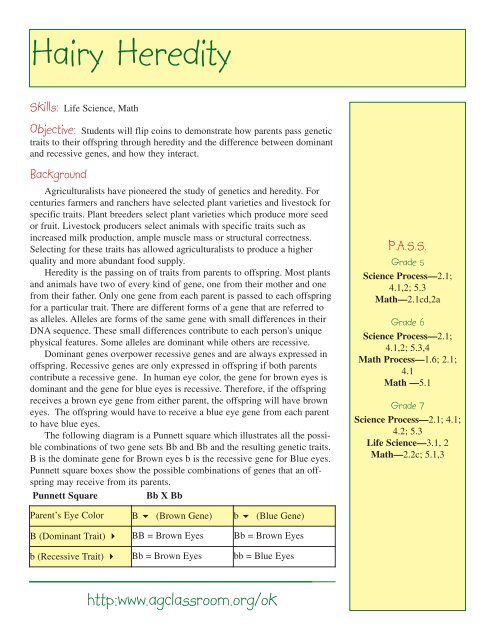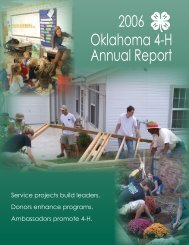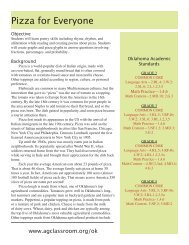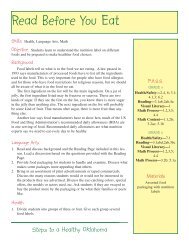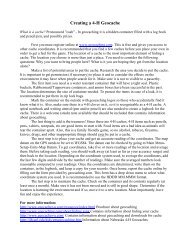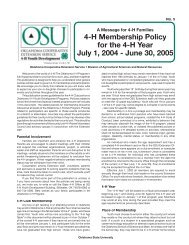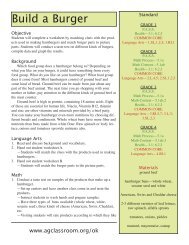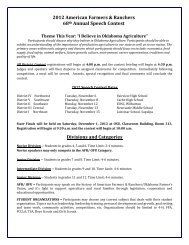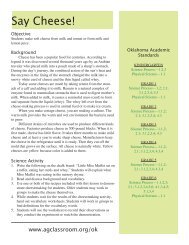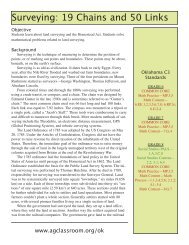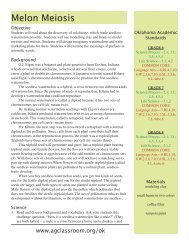Hairy Heredity - Oklahoma 4-H - Oklahoma State University
Hairy Heredity - Oklahoma 4-H - Oklahoma State University
Hairy Heredity - Oklahoma 4-H - Oklahoma State University
Create successful ePaper yourself
Turn your PDF publications into a flip-book with our unique Google optimized e-Paper software.
<strong>Hairy</strong> <strong>Heredity</strong><br />
Skills: Life Science, Math<br />
Objective: Students will flip coins to demonstrate how parents pass genetic<br />
traits to their offspring through heredity and the difference between dominant<br />
and recessive genes, and how they interact.<br />
Background<br />
Agriculturalists have pioneered the study of genetics and heredity. For<br />
centuries farmers and ranchers have selected plant varieties and livestock for<br />
specific traits. Plant breeders select plant varieties which produce more seed<br />
or fruit. Livestock producers select animals with specific traits such as<br />
increased milk production, ample muscle mass or structural correctness.<br />
Selecting for these traits has allowed agriculturalists to produce a higher<br />
quality and more abundant food supply.<br />
<strong>Heredity</strong> is the passing on of traits from parents to offspring. Most plants<br />
and animals have two of every kind of gene, one from their mother and one<br />
from their father. Only one gene from each parent is passed to each offspring<br />
for a particular trait. There are different forms of a gene that are referred to<br />
as alleles. Alleles are forms of the same gene with small differences in their<br />
DNA sequence. These small differences contribute to each person's unique<br />
physical features. Some alleles are dominant while others are recessive.<br />
Dominant genes overpower recessive genes and are always expressed in<br />
offspring. Recessive genes are only expressed in offspring if both parents<br />
contribute a recessive gene. In human eye color, the gene for brown eyes is<br />
dominant and the gene for blue eyes is recessive. Therefore, if the offspring<br />
receives a brown eye gene from either parent, the offspring will have brown<br />
eyes. The offspring would have to receive a blue eye gene from each parent<br />
to have blue eyes.<br />
The following diagram is a Punnett square which illustrates all the possible<br />
combinations of two gene sets Bb and Bb and the resulting genetic traits.<br />
B is the dominate gene for Brown eyes b is the recessive gene for Blue eyes.<br />
Punnett square boxes show the possible combinations of genes that an offspring<br />
may receive from its parents.<br />
Punnett Square<br />
Bb X Bb<br />
P.A.S.S.<br />
Grade 5<br />
Science Process—2.1;<br />
4.1,2; 5.3<br />
Math—2.1cd,2a<br />
Grade 6<br />
Science Process—2.1;<br />
4.1,2; 5.3,4<br />
Math Process—1.6; 2.1;<br />
4.1<br />
Math —5.1<br />
Grade 7<br />
Science Process—2.1; 4.1;<br />
4.2; 5.3<br />
Life Science—3.1, 2<br />
Math—2.2c; 5.1,3<br />
Parent’s Eye Color B (Brown Gene) b (Blue Gene)<br />
B (Dominant Trait) BB = Brown Eyes Bb = Brown Eyes<br />
b (Recessive Trait) Bb = Brown Eyes bb = Blue Eyes<br />
http:www.agclassroom.org/ok
Vocabulary<br />
agriculturalist—someone<br />
involved in the science, art, and<br />
business of cultivating the soil,<br />
producing crops and raising<br />
livestock.<br />
allele—one of two or more<br />
alternative forms of a gene that<br />
controls the same inherited<br />
characteristic.<br />
DNA (deoxyribonucleic<br />
acid)—molecule that contains<br />
genetic information and is<br />
located in the nucleus of every<br />
cell inside an organism.<br />
gene—The basic unit of heredity<br />
that serves as a blueprint for<br />
each protein product produced<br />
in the human body; humans<br />
have over 30,000 genes.<br />
heredity—the passing on of<br />
traits from parents to offspring.<br />
Punnett Square—diagram<br />
used by scientists to help them<br />
to figure out how inherited<br />
traits (characteristics) will be<br />
distributed.<br />
trait—an inherited distinguishing<br />
feature or characteristic of<br />
an organism.<br />
Probability is the chance that something will happen. Using the<br />
above Punnett square box, there is a 75 percent chance of an offspring<br />
having brown eyes if both parents have both dominate and recessive<br />
genes. There is a 25 percent chance of the offspring having blue eyes.<br />
This simple illustration demonstrates how the genetics of one gene<br />
functions. Humans, plants and animals have multiple genes which<br />
have complex interactions to determine offspring traits.<br />
Math and Science<br />
1. Brainstorm to find student knowledge of the transfer of genetic<br />
traits from parents to offspring. Share background material.<br />
2. Give each student a copy of the activity worksheet and a coin.<br />
—Instruct students to flip the coin to determine which traits the<br />
mother will pass on to her offspring. If the coin lands on heads, the<br />
students should circle the dominant trait. If the coin lands on tails,<br />
the students should circle the recessive trait.<br />
—Have students repeat this process for all eight traits from the<br />
mother and father.<br />
—Once all the traits have been randomly selected from the mother<br />
and father, transfer the selected traits to the Genetic Trait<br />
Worksheet.<br />
—Circle the appropriate genetic trait which will be expressed in the<br />
offspring.<br />
3. Hand out the “Smiley Face Worksheet,” and have students draw<br />
and color a smiley face that expresses all the randomly selected<br />
genes.<br />
—Are all the faces the same? How are the faces different? Why?<br />
—Count across the room the number of smiley faces with brown<br />
eyes. Is it 75 percent of the faces, as the Punnett Square predicted?<br />
Do the same for the other traits.<br />
4. Repeat the genetic activity and compare the results with this activity.<br />
Are the results the same? Is the percentage of blue eyes the<br />
same? Other traits?<br />
5. Develop a Punnett square diagram for the other traits. Why is there<br />
a 50 percent chance of the offspring being a girl?<br />
6. . Compare student’s characteristics around the room. Do 75 percent<br />
of the students have brown eyes? What percentage of student’s<br />
eyes are blue or green?<br />
<strong>Oklahoma</strong> Ag in the Classroom is a program of the <strong>Oklahoma</strong> Cooperative<br />
Extension Service, 4–H Youth Development, in cooperation with the<br />
<strong>Oklahoma</strong> Department of Agriculture, Food and Forestry and the <strong>Oklahoma</strong><br />
<strong>State</strong> Department of Education.<br />
<strong>Oklahoma</strong> Ag in the Classroom<br />
<strong>Oklahoma</strong> 4-H Programs<br />
205 4-H Youth Development<br />
<strong>Oklahoma</strong> <strong>State</strong> <strong>University</strong><br />
Stillwater, OK 74078<br />
405-744-8889 http://www.agclassroom.org/ok<br />
http://www.agclassroom.org/ok
Name ______________________________________________________________<br />
<strong>Hairy</strong> <strong>Heredity</strong><br />
Use the flip of a coin to determine which genes your offspring will carry. Flip a coin to determine<br />
which genetic traits each parent will pass on to their offspring. If the coin flip lands on<br />
heads select the dominate trait. If the coin lands on tails, select the recessive trait.<br />
MOTHER’S TRAITS<br />
FATHER’S TRAITS<br />
Flip coin and circle selected trait.<br />
heads<br />
dominant<br />
tails<br />
recessive<br />
heads<br />
dominant<br />
tails<br />
recessive<br />
1. face shape R s 1. face shape R s<br />
2. eye shape<br />
R<br />
o<br />
2. eye shape<br />
R<br />
o<br />
3. eye color<br />
B<br />
b<br />
3. eye color<br />
B<br />
b<br />
4. mouth shape<br />
S<br />
f<br />
4. mouth shape<br />
S<br />
f<br />
5. nose shape<br />
B<br />
l<br />
5. nose shape<br />
B<br />
l<br />
6. skin color<br />
Y<br />
o<br />
6. skin color<br />
Y<br />
o<br />
7. hair<br />
H<br />
b<br />
7. hair<br />
H<br />
b<br />
8. male/female<br />
X<br />
X<br />
8. male/female<br />
X<br />
Y<br />
Produced by <strong>Oklahoma</strong> Cooperative Extension Service, Division of Agricultural Sciences and Natural Resources, OSU, inn cooperation with the<br />
<strong>Oklahoma</strong> Department of Agriculture, Food and Forestry and the <strong>Oklahoma</strong> <strong>State</strong> Department of Education, 2005.
Name ______________________________________________________________<br />
Genetic Trait Worksheet<br />
mother’s<br />
traits<br />
father’s<br />
traits<br />
possible trait combinations<br />
Circle appropriate trait.<br />
sample trait<br />
T<br />
t<br />
tall<br />
T T<br />
tall<br />
T t<br />
short<br />
t t<br />
1. face shape<br />
round<br />
R R<br />
round<br />
R s<br />
square<br />
s s<br />
2. eye shape<br />
round<br />
R R<br />
round<br />
R o<br />
oval<br />
o o<br />
3. eye color<br />
brown<br />
B B<br />
brown<br />
B b<br />
blue<br />
b b<br />
4. mouth shape<br />
smile<br />
S S<br />
smile<br />
S f<br />
frown<br />
f f<br />
5. nose shape<br />
big<br />
B B<br />
big<br />
B l<br />
little<br />
l l<br />
6. skin color<br />
yellow<br />
Y Y<br />
yellow<br />
Y o<br />
orange<br />
o o<br />
7. hair<br />
hairy<br />
H H<br />
hairy<br />
H b<br />
bald<br />
b b<br />
8. male/female<br />
male<br />
X y<br />
female<br />
X X<br />
n/a<br />
Produced by <strong>Oklahoma</strong> Cooperative Extension Service, Division of Agricultural Sciences and Natural Resources, OSU, inn cooperation with the<br />
<strong>Oklahoma</strong> Department of Agriculture, Food and Forestry and the <strong>Oklahoma</strong> <strong>State</strong> Department of Education, 2005.
Name ______________________________________________________________<br />
Smiley Face Worksheet<br />
1. face shape<br />
round / square<br />
2. eye shape<br />
round / oval<br />
3. eye color<br />
brown / blue<br />
4. mouth shape<br />
smile / frown<br />
5. nose shape<br />
big / little<br />
6. skin color<br />
yellow / orange<br />
7. hair<br />
hairy / bald<br />
8. male/female<br />
boy / girl<br />
Draw and color the offspring’s smiley face<br />
Add details to identify your smiley as a boy or girl.<br />
offspring’s name____________________<br />
Produced by <strong>Oklahoma</strong> Cooperative Extension Service, Division of Agricultural Sciences and Natural Resources, OSU, inn cooperation with the<br />
<strong>Oklahoma</strong> Department of Agriculture, Food and Forestry and the <strong>Oklahoma</strong> <strong>State</strong> Department of Education, 2005.


